traction control CHEVROLET CAMARO 1993 Owners Manual
[x] Cancel search | Manufacturer: CHEVROLET, Model Year: 1993, Model line: CAMARO, Model: CHEVROLET CAMARO 1993Pages: 358, PDF Size: 15.6 MB
Page 74 of 358
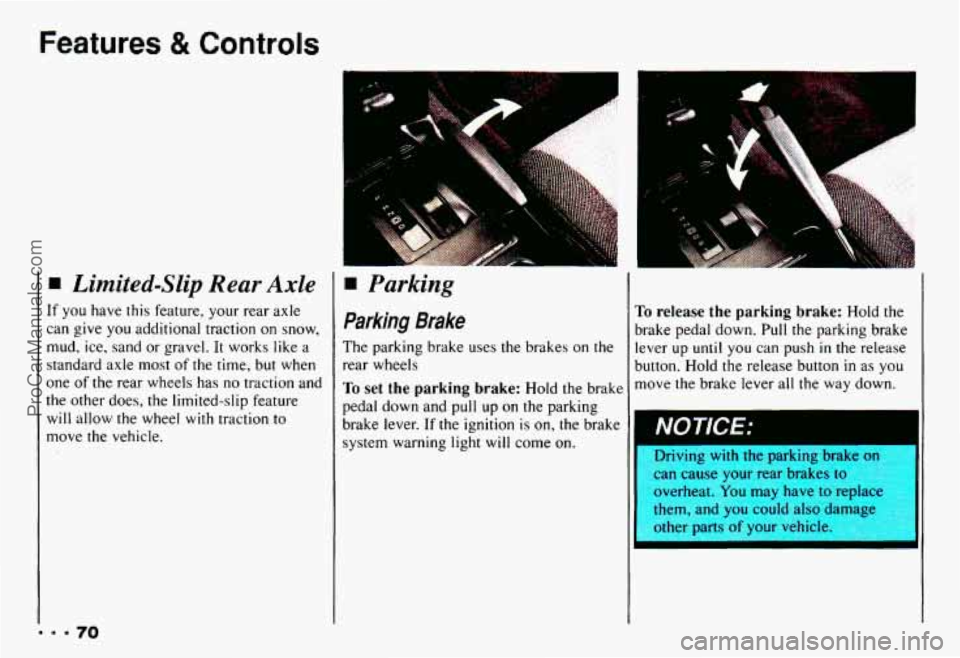
Features & Controls
fl Limited-Slip Rear Axle
If you have this feature, your rear axle
can give
you additional traction on snow,
mud, ice, sand or gravel. It works like a
standard axle most
of the time, but when
one
of the rear wheels has no traction and
the other does, the limited-slip feature
will allow the wheel
with traction to
move the vehicle.
Purking
Parking Brake
The parking brake uses the brakes on the
rear wheels
To set the parking brake: Hold the brake
pedal down and pull up
on the parking
brake lever.
If the ignition is on, the brake
system warning light
will come on.
J
To release the parking brake: Hold the
brake pedal down. Pull the parking brake
lever up
until you can push in the release
button. Hold the release button
in as you
move the brake lever all the way down.
-
on Driving with the parking bra
cause your rear brakes tc
overheat. You may have to replace
them, and you could also
da: ge
sther parts of your vehicl
ProCarManuals.com
Page 84 of 358
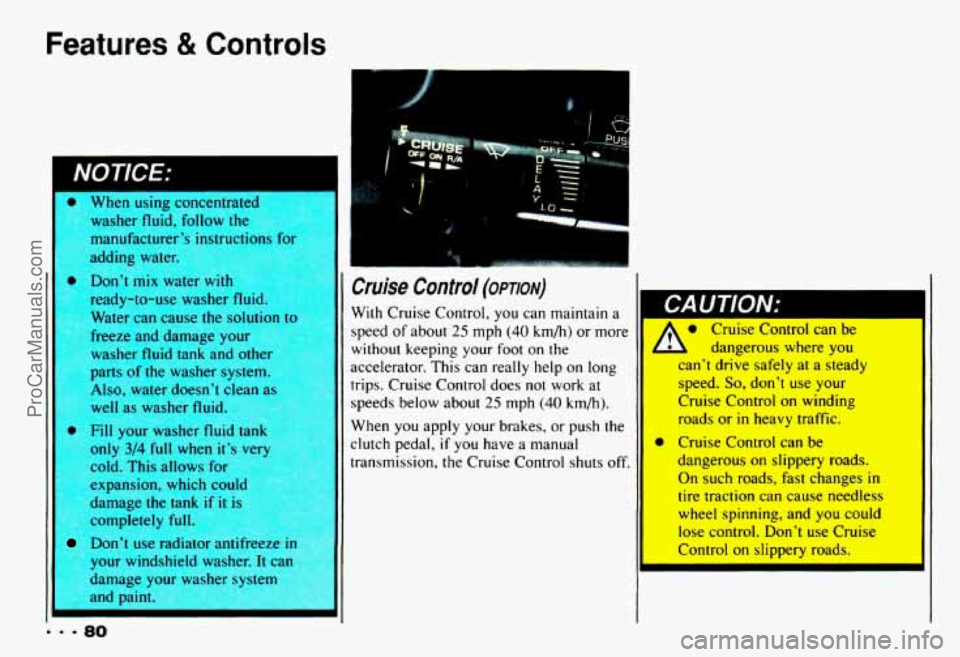
Features & Controls
II
washer fluid, follow the
manufacturer’? instructiopc
fnr
adding water.
Don’t mix warGI with
ready-to-use washer
fluic..
Water can cause the solutinn tn
freeze and damage your
washer
fluid tank and other
parts of the washer systen
Also, water doesn’t clean as
well as washer fluid.
Fill your washer fluid tank
only
3/4 full when it’s ver
cold. This allows
fo
expansion, which COUI(
damage the tank if it is
completely full.
Don’t use radiator anurreeze In
your windshield washer. It can
and paint. damage yolw
wacher cvctpm
-=-8O I
Cruise Control (opmv)
With Cruise Control, you can maintain a
speed of about
25 mph (40 km/h) or more
without keeping your foot on the
accelerator. This can really help on long
trips. Cruise Control does not work
at
speeds below about 25 mph (40 km/h).
When
you apply your brakes, or push the
clutch pedal,
if you have a manual
transmission, the Cruise Control shuts off.
Cruise Control can be
1 L dangerous where you
can’t drive safely at a steady
speed.
So, don’t use your
Cruise Control
on winding
roads or
in heavy traffic.
dangerous
on slippery roads.
On such roads, fast changes in
tire traction can cause needless
wheel spinning, and you
could
lese control. hn’t use Cruise
* Cruise Control can be
ProCarManuals.com
Page 148 of 358
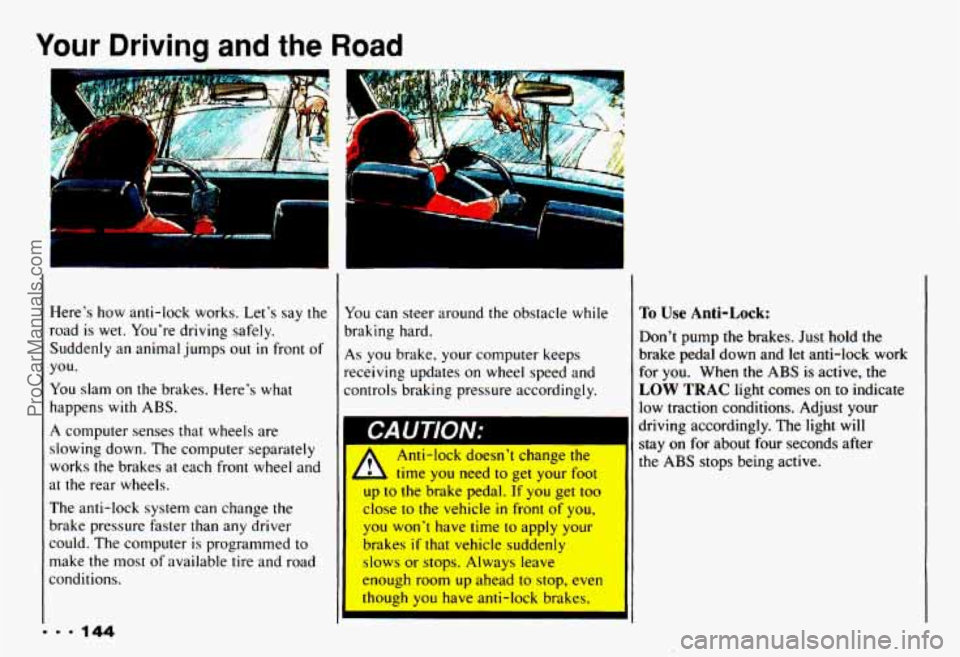
Your Driving and the Road
I
Here's how anti-lock works. Let's say the
road is wet. You're driving safely.
Suddenly an animal jumps out
in front of
you.
You slam on
the brakes. Here's what
happens with ABS.
A computer senses that wheels are
slowing down. The computer separately
works the brakes at each front wheel and
at the rear wheels.
The anti-lock system can change
the
brake pressure faster than any driver
could. The computer is programmed
to
make the most of available tire and road
conditions.
1
You can steer around the obstacle while
braking hard.
As you brake, your conlputer keeps
receiving updates
on wheel speed and
controls braking pressure accordingly.
I CAUTION;
A
Anti-lock doesn't change the
time
you need to get your foot
up
to the brake pedal. If you get too
close
to the vehicle in front of you,
1 you won't have time to apply your
brakes
if that vehicle suddenly
slows or stops. Always leave
enough room up ahead
to stop, even
though
you have anti-lock brakes.
I'o Use Anti-Lock:
Don't pump the brakes. Just hold the
brake pedal down and
let anti-lock work
for you. When the
ABS is active, the
LOW TRAC light comes on to indicate
low traction conditions. Adjust your
driving accordingly. The light will
stay on for about four seconds after
the
ABS stops being active.
ProCarManuals.com
Page 150 of 358
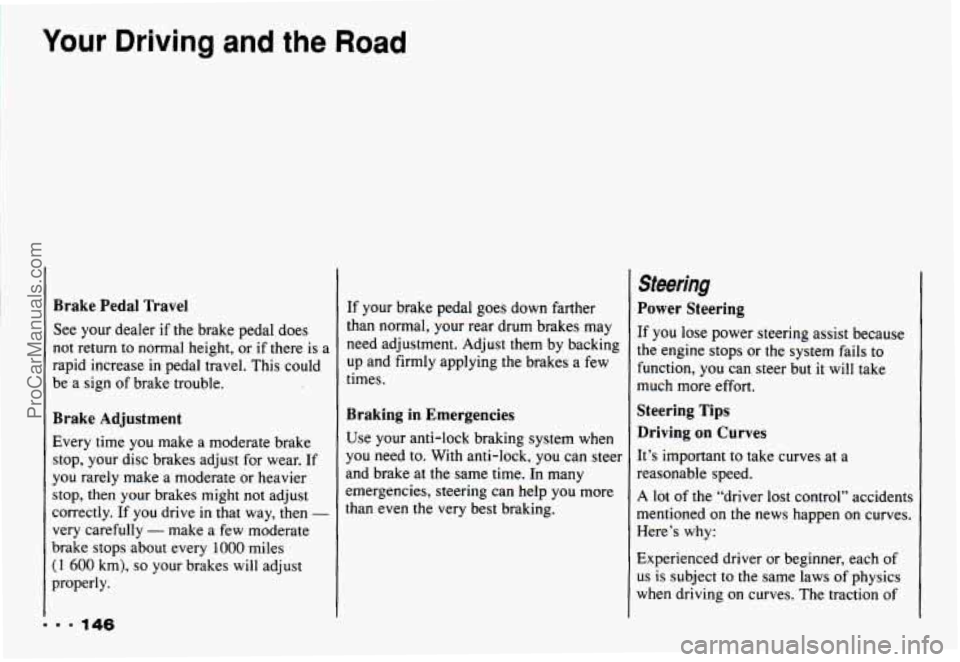
Your Driving and the Road
Brake Pedal Travel
See your dealer if the brake pedal does
not return to normal height, or if there is a
rapid increase
in pedal travel. This could
be a sign of brake trouble.
Brake Adjustment
Every time you make a moderate brake
stop, your disc brakes adjust for wear. If
you rarely make a moderate or heavier
stop, then your brakes might not adjust
correctly. If you drive in that way, then
-
very carefully - make a few moderate
brake stops about every
1000 miles
(1 600 km), so your brakes will adjust
properly. If
your brake pedal goes down farther
than normal, your rear drum brakes may
need adjustment. Adjust them by backing up and firmly applying the brakes a few
times.
Braking in Emergencies
Use your anti-lock braking system when
you need to. With anti-lock, you can steer
and brake at the same time. In many emergencies, steering can help you more
than even the very best braking.
Steering
Power Steering
If you lose power steering assist because
the engine stops or the system fails to
function, you can steer but
it will take
much more effort.
Steering Tips
Driving on Curves
It’s important to take curves at a
reasonable speed.
A lot of the “driver lost control” accidents
mentioned on the news happen on curves.
Here’s why:
Experienced driver or beginner, each of
us is subject to the same laws of physics
when driving on curves. The traction of
ProCarManuals.com
Page 151 of 358
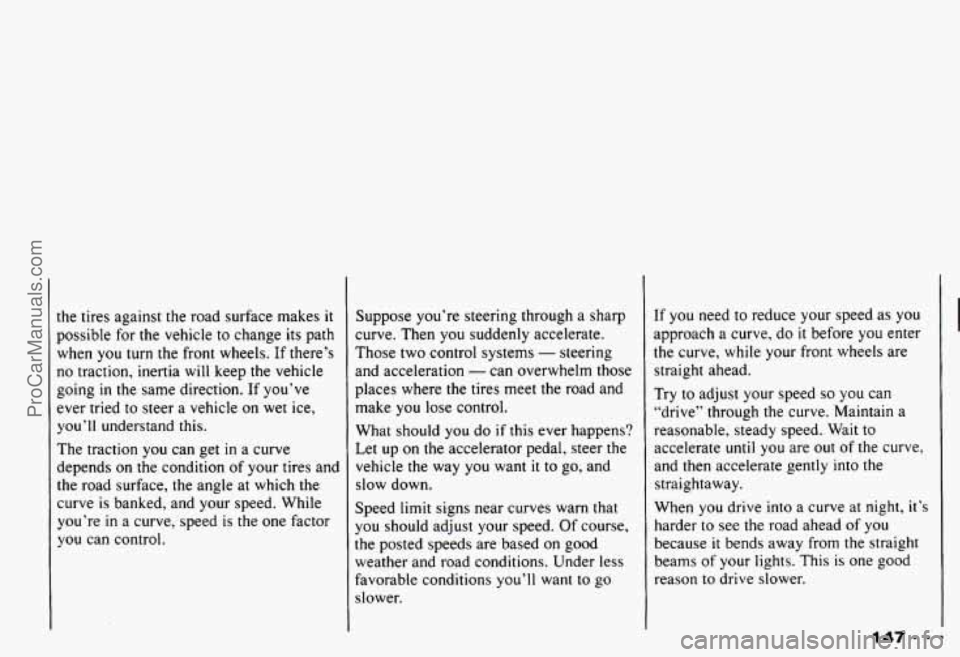
the tires against the road surface makes it
possible for the vehicle to change its path
when
you turn the front wheels. If there’s
no traction, inertia will keep the vehicle
going
in the same direction. If you’ve
ever tried to steer a vehicle on wet ice,
~ you’ll understand this.
The traction you can get
in a curve
depends on the condition of your tires and
the road surface, the angle at which the
curve is banked, and your speed. While
you’re
in a curve, speed is the one factor
you can control. Suppose you’re
steering through a sharp
curve. Then you suddenly accelerate.
Those two control systems
- steering
and acceleration
- can overwhelm those
places where the tires meet the road and
make you lose control.
What should you do
if this ever happens?
Let up on the accelerator pedal, steer the
vehicle the way you want
it to go, and
slow down.
Speed limit signs near curves warn
that
you should adjust your speed. Of course,
the posted speeds are based on good
weather and road conditions. Under less
favorable conditions you’ll want to
go
slower.
If you need to reduce your speed as you
approach
a curve, do it before you enter
the curve, while your front wheels are
straight ahead.
Try to adjust your speed so you can
“drive” through the curve. Maintain a
reasonable, steady speed. Wait to
accelerate
until you are out of the curve,
and then accelerate gently into the
straightaway.
When you drive into a curve at night, it’s
harder
to see the road ahead of you
because
it bends away from the straight
beams
of your lights. This is one good
reason to drive slower.
ProCarManuals.com
Page 156 of 358
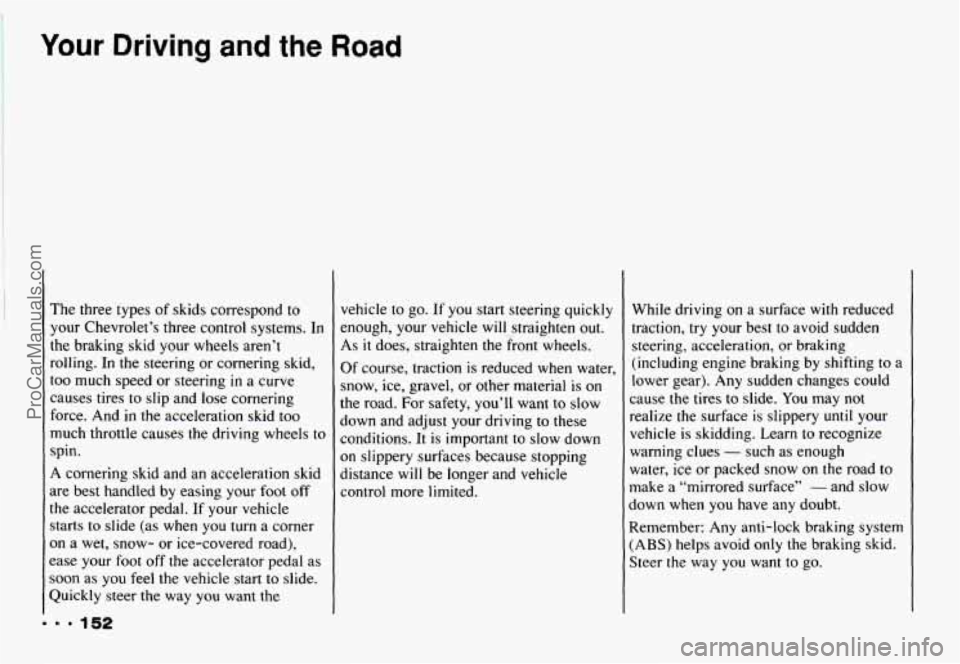
Your Driving and the Road
The three types of skids correspond to
your Chevrolet’s three control systems. In
the braking skid your wheels aren’t
rolling. In the steering or cornering skid,
too much speed or steering in a curve
causes tires to slip and lose cornering
force. And
in the acceleration skid too
much throttle causes the driving wheels to
spin.
A cornering skid and an acceleration skid
are best handled by easing your foot off
the accelerator pedal. If your vehicle
starts to slide (as when you turn a corner
on a wet, snow- or ice-covered road),
ease your
foot off the accelerator pedal as
soon as you feel the vehicle start to slide.
Quickly steer the way
you want the vehicle to
go. If you
start steering quickly
enough, your vehicle will straighten out.
As it does, straighten the front wheels.
Of course, traction
is reduced when water,
snow, ice, gravel, or other material is on
the road. For safety, you’ll want to
slow
down and adjust your driving to these
conditions. It is important to slow down
on slippery surfaces because stopping
distance will be longer and vehicle control more limited. While
driving on a surface
with reduced
traction,
try your best to avoid sudden
steering, acceleration, or braking
(including engine braking by shifting to a
lower gear). Any sudden changes could
cause the tires to slide.
You may not
realize the surface is slippery until your
vehicle is skidding. Learn to recognize
warning clues
- such as enough
water, ice or packed snow on the road to
make
a “mirrored surface” - and slow
down when you have any doubt.
Remember:
Any anti-lock braking system
(ABS) helps avoid only the braking skid.
Steer the way you want to go.
ProCarManuals.com
Page 265 of 358
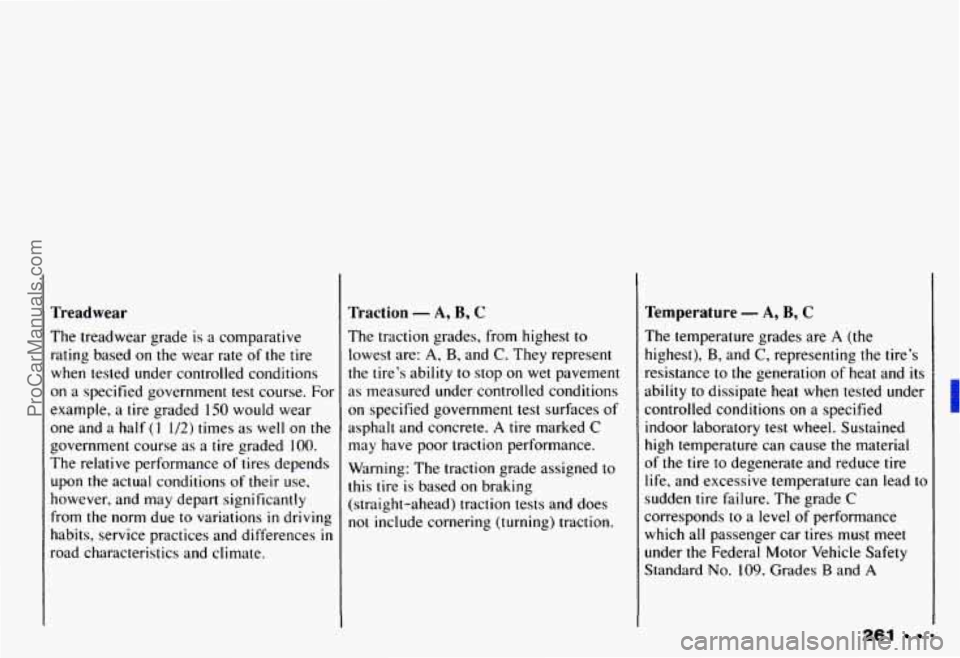
Treadwear
The treadwear grade is a comparative
rating based on the wear rate of the tire
when tested under controlled conditions
on a specified government test course. For
example, a tire graded
150 would wear
one and a half
(1 1/2) times as well on the
government course as a tire graded
100.
The relative performance of tires depends
upon the actual conditions of their use,
however, and may depart significantly
from the norm due
to variations in driving
habits, service practices and differences
in
road characteristics and climate.
Traction - A, B, C
The traction grades, from highest to
lowest are:
A, B, and C. They represent
the tire’s ability
to stop on wet pavement
as measured under controlled conditions
on specified government test surfaces of
asphalt and concrete.
A tire marked C
may have poor traction performance.
Warning: The traction grade assigned
to
this tire is based on braking
(straight-ahead) traction tests and does
no1 include cornering (turning) traction.
Temperature - A, B, C
The temperature grades are A (the
highest),
B, and C, representing the tire’s
resistance to the generation of heat and
its
ability to dissipate heat when tested under
controlled conditions on a specified
indoor laboratory test wheel. Sustained
high temperature can cause the material
of the tire to degenerate and reduce tire
life, and excessive temperature can lead to
sudden tire failure. The grade
C
corresponds to a level of performance
which all passenger car tires must meet
under the Federal Motor Vehicle Safety
Standard
No. 109. Grades B and A
261
ProCarManuals.com
Page 346 of 358
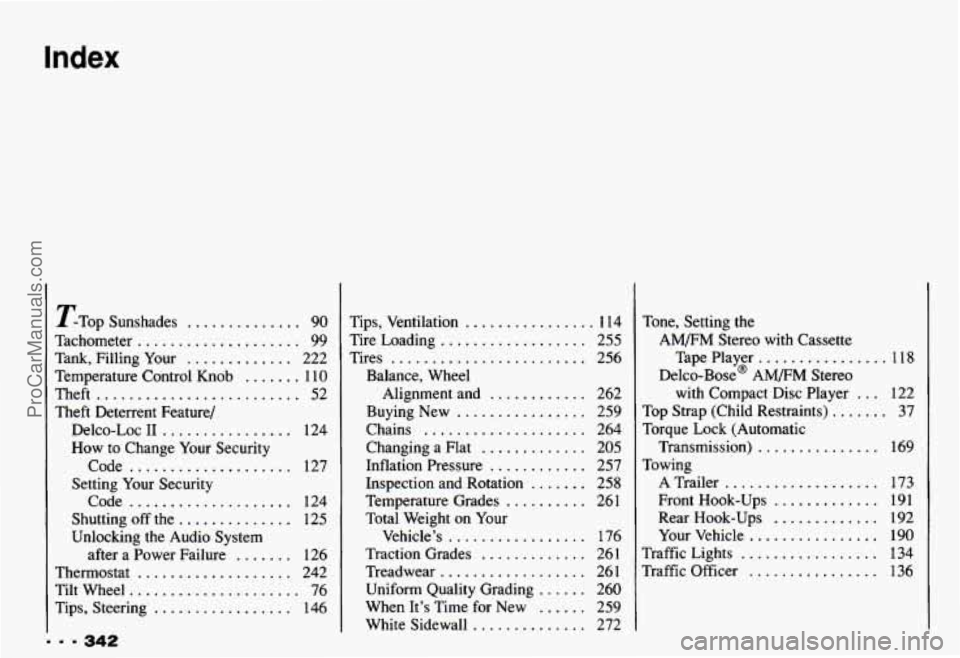
Index
... 342
TTop Sunshades .............. 90
Tachometer
.................... 99
Tank. Filling Your ............. 222
Temperature Control Knob
....... 110
Theft ......................... 52
Theft Deterrent Feature/
Delco-Loc
I1 ................ 124
How to Change Your Security
Code
.................... 127
Setting Your Security
Code
.................... 124
Shutting
off the .............. 125
Unlocking the Audio System after a Power Failure
....... 126
Thermostat
................... 242
Tilt Wheel
..................... 76
Tips. Steering
................. 146 Tips. Ventilation
................ 1 14
Tire Loading
.................. 255
Tires
........................ 256
Balance. Wheel
Alignment and
............ 262
Buying New
................ 259
Chains .................... 264
Inflation Pressure
............ 257
Changing a Flat
............. 205
Inspection and Rotation
....... 258
Temperature Grades
.......... 261
Total Weight on Your
Vehicle’s
................. 176
Traction Grades
............. 261
Treadwear
.................. 26 1
Uniform Quality Grading ...... 260
When It’s Time for New
...... 259
White Sidewall
.............. 272 Tone.
Setting the
AM/FM Stereo with Cassette
Delco-Base@ AMEM Stereo
Tape
Player
................ 118
with Compact Disc Player
... 122
Top Strap (Child Restraints)
....... 37
Torque Lock (Automatic
Towing Transmission)
............... 169
A Trailer
................... 173
Front Hook-Ups
............. 191
Rear Hook-Ups
............. 192
Your Vehicle
................ 190
Traffic Lights ................. 134
Traffic Officer
................ 136
ProCarManuals.com